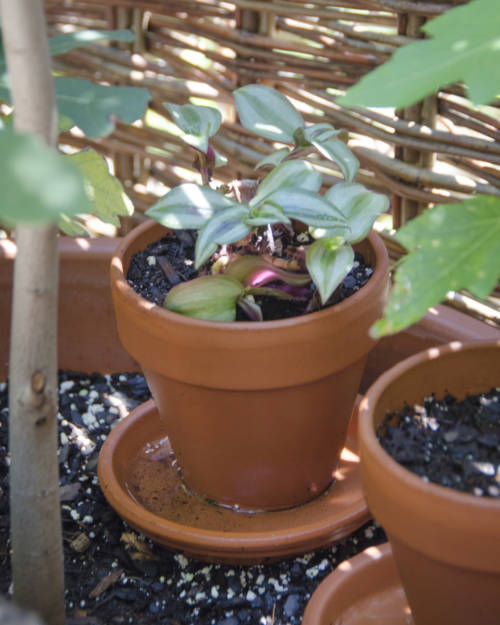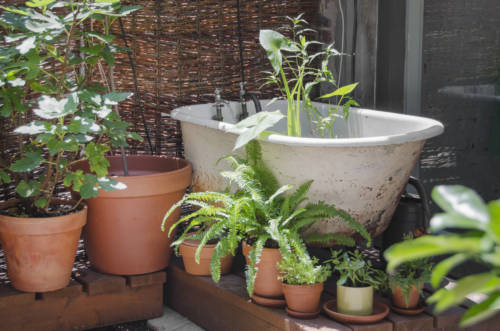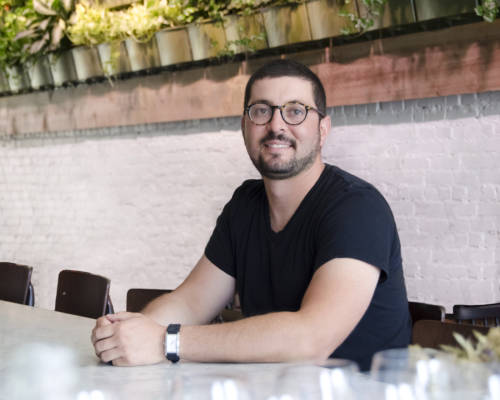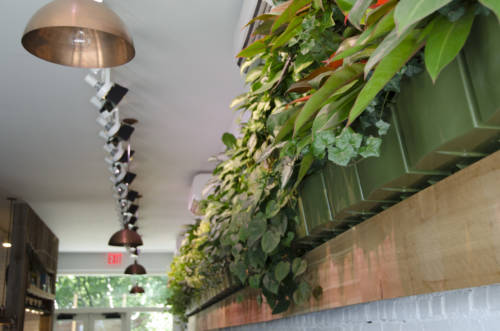
Ian Rothman, Micro-Farming Expert, On His Pioneering Work at Olmsted
New York has always been a city known for its food-based innovation, but a minor revolution in the farm-to-table movement is growing in Brooklyn, most notably in the backyard of a pioneering new restaurant called Olmsted. The Prospect Heights outpost begins modestly at the curb of Vanderbilt Avenue, where a planting of rainbow chard and other edibles sit at the base of a mature hornbeam tree on the street…
And that vibe continues through to the restaurant. Greenery makes a path along the brick wall to the back garden, where Farmer Ian Rothman and Chef Greg Baxtrom have coupled the rigors of closed-loop farming methods with top-notch culinary techniques to create a seamless garden-to-table partnership. Grow-perfect produce? Done. Recycled kitchen heat exhaust and repurposed food scraps onsite? Check. Keeping costs controlled so that this classy resto has the potential to become an affordable neighborhood joint? Double-check. Do it all on a scale that makes sense in NYC’s famously-limiting square footage? Mission accomplished. Or at least: mission in progress.
It’s a proof of concept Rothman says, walking through the garden. Certainly, it’s a helluva think-piece. A grouping of Fig and Paw Paw trees suggest an orchard. Hop and grape vines are beginning their scramble up the back wall. A repurposed claw foot tub houses crayfish and water-loving plants, and is deliberately situated over the restaurant’s heat vent, creating a season-extending micro-climate. Oh, that bin sitting quietly in the corner? Another waste-not moment: food scraps are fed to black fly larva, which are in turn fed to quail (in the other corner) and crayfish. Forget Broadway, the Circle of Life is happening right here.
“One tomato seed is this tiny thing that you can’t even weigh on a scale, yet you can get ten pounds of tomatoes over the course of a season if you just pay attention to it. That really blew my mind and inspired me.”
Perennial crops ring the space that Olmsted has dedicated to gardening: horseradish grows next to sunchokes; asparagus is sending out feathery shoots, feeding the roots for the following spring harvest; rows and rows of radishes demo succession planting, a farming method that ensures there is product on the table now, and three weeks from now. On and on. Among all the plantings, tables and benches that Rothman and Baxtrom built themselves invite you to grab a drink and settle in to this space.
After giving us a quick tour of the space, Rothman kindly answered a few questions about how his particular genius for transforming corners of NYC into minor patches of paradise came to be; he also spoke eloquently about how the chef/farmer pairing is one of the most natural combinations in the food biz, and how the NYC food scene has changed his vision for commodity farming for the better.
GC: So, where did all this start for you?
IR: “When I was in middle school my grandmother, who lived in Brighton Beach, passed away. We went to her house and were all allowed to take something from her estate that was important to us. I picked this plant, which was a dumb cane, and I picked a couple chairs that still live at my parent’s house. That plant stayed in my room, but I didn’t care for it– my mom cared for it.
I brought it with me to college, and it promptly started dying. And I was thinking ‘Oh no, I can’t lose this thing, it has so much sentimental value‘. So I went to my friend that had so many plants in her room, and I was like, ‘You’ve got to help me’. We took cuttings and we rooted them in water, and went to sand and then potted them back into soil, and we saved the plant. And I was like, ‘Oh my gosh how did you learn this?’
She had taken this organic farming and gardening class at [UMass Amherst]. So I signed up for it, and the professor turned out to be someone I got along with really well. I didn’t have any kind of direction at that moment, but it was something I was enjoying. I went to the advisor, and she was like, ‘This is how you can get this degree in 4 years‘. And I was like, ‘Sign me up. I’ll do it.‘ That’s how it started.”
“One of the grad students in the program was starting a farm, so I helped him with his first two years, and just became more excited and enthralled by growing food. One tomato seed is this tiny thing that you can’t even weigh on a scale, yet you can get ten pounds of tomatoes over the course of a season if you just pay attention to it. That really blew my mind and inspired me. So, I started growing food.”
A couple years out of school, I founded Fair Weather Farm with another friend, in 2005. We spent maybe 6K on some equipment and a pickup truck and we were in business. We were in a small town that is a right-to-farm community. It was $35 to get the permit to operate as a farm business! My partner was an avid snowboarder who taught in the winter lessons in the winter and was growing food for his family on his family farm. I had come from this large scale commodity agriculture background in a university setting, and he was doing this homesteading garden and we had great conversations. We were like, ‘We might as well talk about this all day while we’re weeding carrots‘. It really came about naturally, so we decided to go for it.”
GC: That sounds like how Olmsted has evolved– from this natural partnership that you have with Chef Baxtrom.
IR: “Yeah, absolutely. We met while at Atera, and that was a really incredible experience. When I moved to New York, I always assumed that I would move out of the city and have a farm again, and I still believe that. But the farm, in my mind, has changed so much from before I worked in a place that was trying to be the best in the world. I’ve learned so much about how to better cater to restaurants and grow the kind of things that they want.”
GC: What does that look like?
IR: “It’s really about size. Restaurants want things smaller than farmers generally want to grow them. For example, potatoes can only be sold for so much a pound, so why not grow big ones so you’re making more money per potato. But, in New York, chefs and restaurants see the value and are willing to pay more for really nicely done, smaller, produce.
So here [at Olmsted], what we’ve done is become intelligent about how we make the menu. With our [radish top] gazpacho, we can get the nicest ones because we’re using all of [the radish plant]. We’re using it in two ways as opposed to using just one part. That way, we can have a very approachable price point while also using the greatest ingredients from the market, all while reducing waste.
This is what Greg and I do all day. Well, now he gets to cook a lot. But, when we hang out, all we do is just think about something and tease out every aspect of [the idea] to see how we can do it better.
GC: I’m curious to hear more about why you moved from farming at scale to farming in New York. What brought you here?
IR: So, our farm was a particular size and in a particular location. It could support one family, and probably not two. [My partner’s] family owned it, and he was having a kid. So it became clear that it was time for me to move on. I’m originally from Connecticut, and all of my friends and family has lived in NYC at one time. I had a support system of people here, so I moved to New York.
I got a job at a butcher shop in the Chelsea Market, Dicksons, which is unique because they break full animals down in the shop and they deal specifically with six family farms. I was like, ‘This is in the same vein of what I’m into: supporting farms and educating people about agriculture.’
One of our customers just worked for a restaurant that was in the space that Atera filled. When that restaurant was closing, she told me that I should meet this new chef because we’d have a lot in common. So Matt and I started having a couple conversations over coffee. He had just come from Portland where there’s access to the outdoors in the most extreme sense. He was like, “We need to have a garden and I don’t know how we’re going to do it,” and we just kind of brainstormed this idea of how to create a garden two stories beneath the restaurant in what had been a storage closet.
GC: So everywhere you land you are gardening or farming. That’s brilliant. And, that it can be done in so many different formats.
IR: “Absolutely. I’ve really come to understand that you can have things growing anywhere; it’s just a matter of commitment. Whether that’s time, or money, or just the know-how, you can make things grow.”
GC: And now you’ve tackled a new set of variables, with Olmsted’s outdoor garden.
IR: “At first, our idea was that this wall [the glass between the restaurant and the garden] was a divider. This was Greg’s house and that was Ian’s house; but the blending of the two is really the most rewarding thing. Any night, there are people out there engaging with their surroundings.
We like that the plants grow out into the benches, because you’re sitting there literally nuzzling against the plants. They’re just forcing you to notice them and to ask about them. It is really exciting to have built something and to watch people enjoy it as much as they do. It’s an oft-Instagrammed spot.”






































